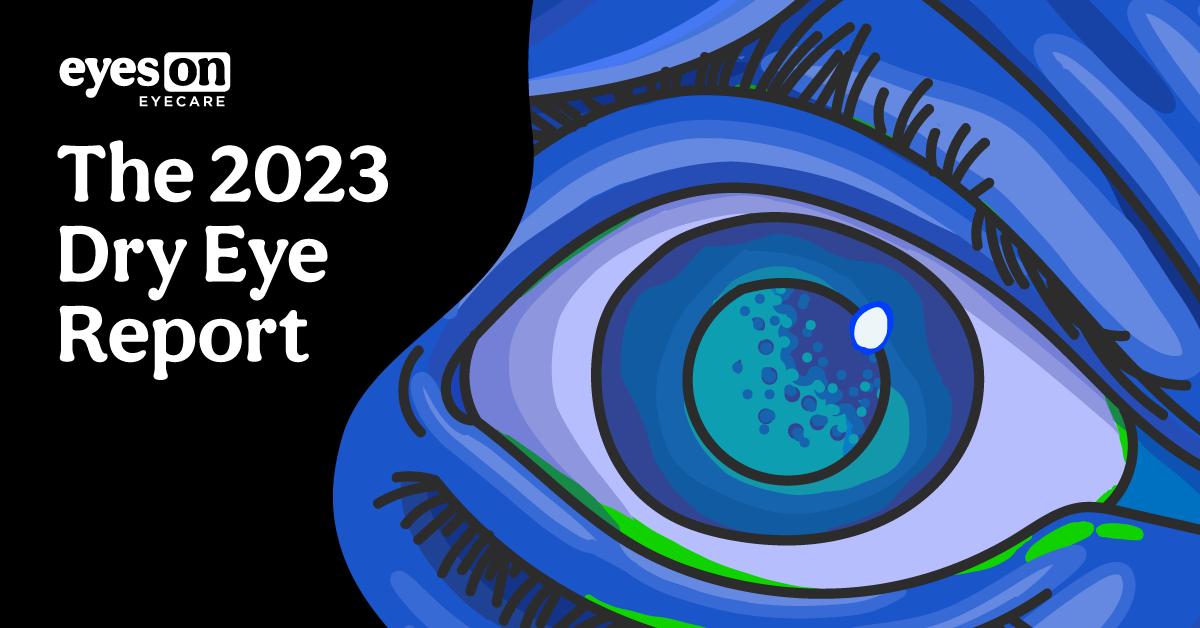Dry eye disease (DED) affects an estimated 50 million people in the United States, with approximately 35 million that are undiagnosed.
1-3 The prevalence increases each year due to a variety of intrinsic and extrinsic factors that practitioners suggest could include increasing digital device usage, age, diet, autoimmune and systemic disease, and environmental conditions.
In January 2023, Eyes On Eyecare surveyed 428 optometrists in the US and Canada who currently diagnose and manage dry eye to learn more about how the optometric community approaches this disease.
In this 3rd Annual
Eyes On Eyecare Dry Eye Report, we present to you the results of this survey—and, as with all of our reports, the data is absolutely free to access!
Download the 2023 Dry Eye Report now, or keep reading for a sneak peek at the findings!
The 2023 Dry Eye Report
Review shifting trends in the field and how optometrists successfully diagnose, treat, and manage dry eye.
JUST RELEASED: The 2025 Dry Eye Report
Get insights from hundreds of optometrists in the highly-anticipated 2025 Dry Eye Report! Explore trends, treatments, tools, and advice to help you stay ahead in dry eye management, all for FREE! Click here to download!
The 2023 Dry Eye Report covers:
- Confidence in diagnosis and treatment: How comfortable are optometrists with diagnosing and treating this condition?
- Screening, diagnostics, and point-of-care systems: What are the most common diagnostic methods used by optometrists in 2023? How frequent are certain diagnoses? How many ODs are utilizing validated dry eye questionnaires?
- Treatment and management of DED, eye dryness, and dry eye flares: How do ODs classify their approach to DED? What are their go-to treatments by dry eye type? What new approaches are ODs incorporating into their practices?
- Practice management: How many ODs are expanding their dry eye offerings?
- Advice from fellow practitioners: Throughout the report, keep an eye out for tips and advice from fellow optometrists on how to grow your practice, where to start, and how to discuss it with patients!
- And more!
Optometrists are more confident with dry eye than last year
Confidence in diagnosing, treating, and managing dry eye has increased across the board by 2 to 3% from 2022, with 2023 averages at 8.09/10 for confidence in diagnosis and 7.7/10 for confidence in treatment.
Rate your confidence in diagnosing Dry Eye Disease.
Rate your confidence in treating Dry Eye Disease.
This brings 2023 numbers back in line with those from the
2021 report, suggesting that the dip in confidence in 2022 was short-lived. Optometrists continue to educate themselves regarding old and new treatment options, as well as strengthen their ability to comfortably address their patients’ dry eye.
With enhanced proficiency comes new DED treatments
Optometrists are also diversifying their approaches: In 2023, respondents reported using a wider range of treatments than was found in last year’s survey data.
This included
in-office treatments, like thermal heat systems,
intense pulsed light, and radiofrequency for MGD, as well as conventional therapies, such as OTC topical treatments, prescription-based treatments (up almost 50% from last year!), and eyelid hygiene.
This year,
68.7% of optometrists reported
topical steroids as their go-to treatment for dry eye flares. The significant adoption of steroid use in treating acute exacerbations of dry eye is in the recognition that patient symptoms (i.e., visual fluctuations, redness, blink alterations) can ebb and flow, necessitating flare management.
It is evident from this data that optometrists are ready and willing to address the inflammatory response head-on to proactively mitigate dry eye flares, which could occur multiple times throughout the year.
Implementation Pathways to Dry Eye Practice Success
Elevate your expertise, boost your revenue, and stay on the cutting edge of dry eye treatments with this exclusive series featuring top educators in the field. Explore the series >>
More optometrists plan to grow their OSD line of service
As optometrists continue to explore the many avenues of dry eye treatment, we hope this report will offer useful insights and support for doctors seeking to grow their practice!


